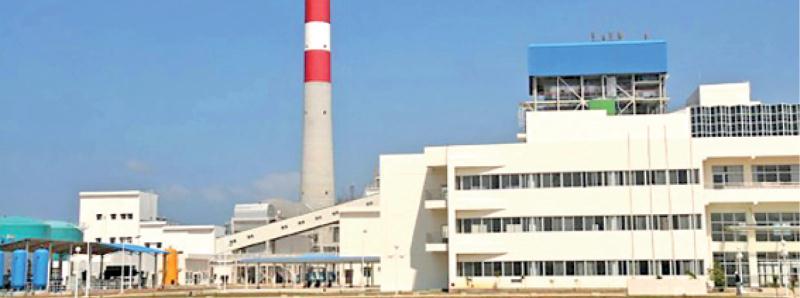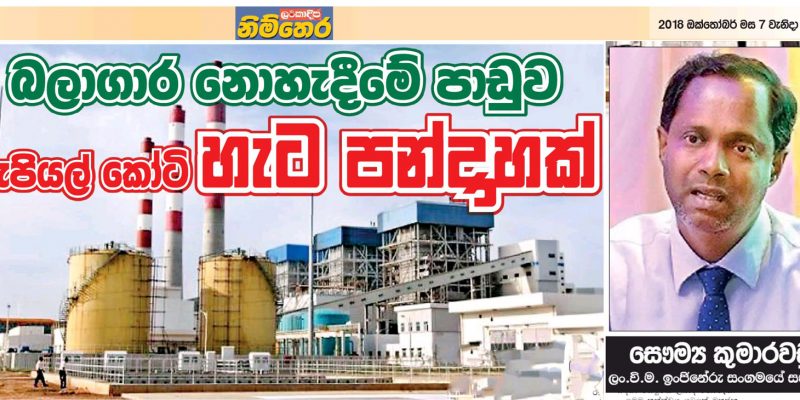By Namini Wijedasa
The Power and Energy Ministry extended for a second time the deadline for companies to counter a Korean bid for an offshore floating storage and regasification unit (FSRU), pipeline and liquefied natural gas (LNG).
Bidders have now been given until February 28 to submit counter proposals under the Swiss Challenge procedure for the project, which will serve the Ceylon Electricity Board (CEB). The first extension ended on Thursday. The Ministry initially advertised the contract in October last year, amidst political turmoil, granting prospective bidders just five weeks to apply.
The decision to extend was influenced by pressure from the CEB, Ministry sources said. Three members of the CEB resigned this week from the Swiss Challenge technical evaluation committee (TEC) protesting what they claimed were Ministry Secretary Suren Batagoda’s “high-handedness” and imposition of “ad hoc procedures”.
Earlier, the utility’s General Manager and its union of engineers had written to Ministry Secretary Suren Batagoda opposing moves to award the 20-year take-or-pay contract for LNG to a single entity. Both Mr A K Samarasinghe and the CEB Engineers’ Union (CEBEU) urge that the bid be “unbundled” into separate contracts for LNG supply and LNG infrastructure development.
“The unbundling of these two contracts is an absolute necessity to ensure more competition, transparency and best possible prices,” the CEBEU says. It calls for the Ministry to follow a competitive bidding process — rather than a Swiss Challenge — to procure LNG and to develop LNG infrastructure based on a “proper” request for proposals (RFP) document to ensure “transparency, fair competition and the maximum benefit at minimum cost to the country”.
It is also proposed that, instead of tying the country down to a 20-year deal, to limit LNG to a 10-year medium-term contract “due to the unpredictable LNG ecosystems in the world”. The CEBEU has warned that the value of the agreement, even in the medium term, could “easily go into trillions of rupees”.
The unsolicited bid first came from South Korea’s M/s SK E&S Company Ltd. The Ministry opened it out to other bidders “in order to allow this proposal to compete with other possible investors”. “If the original proponent is unable to match the counter proposal, the tender will be awarded to the prospective bidder, provided the agreement to pay the development cost of the original proponent,” the Ministry’s advertisement said.
The project includes the design, construction and installation of an FSRU to be moored approximately 9 km north-northwest of the Colombo Port entrance; supply of LNG (including transportation) by LNG carrier vessel to be moored near the FSRU; LNG to be re-gassified on board the FSRU with re-gassified LNG sent into two subsea pipelines. Each pipeline will then be routed to the power plants located at Kelanitissa and Kerawalapitiya.
The CEB has opposed the Swiss Challenge, saying such procedures are usually recommended where the buyer — in this case, the utility — is not capable of developing an RFP or where the seller is proposing an “extraordinary solution” having clear advantages over standard procedure. LNG procurement does not fall into either category. The utility maintains that it can develop a proper RFP with the assistance of a consultant.
“We also understand that there are a few other unsolicited proposals in the guise of Government-to-Government offers such as proposals from India/Japan/Sri Lanka and China/Sri Lanka joint partnerships to deploy LNG in Sri Lanka,” the CEBEU tells the Ministry, urging the Secretary not to proceed with them. “These proposals drastically deviate from the above detailed guidelines.”
However, new Power and Energy Minister Ravi Karunanayake (who was briefly in Singapore this week) has shown eagerness to proceed with the Korean Swiss Challenge. A cabinet paper is being prepared to nudge the process along, authoritative sources said.
Dr Batagoda also defends the project. He said, while the contracts could be unbundled into two, the Korean proposal ensures that the CEB gets the FSRU and pipeline for free. A joint venture will be formed for management in which the utility will hold a 49 percent stake. But ownership will be Sri Lanka’s “from day one”.
The CEB contends, however, that it must not be held hostage to this proposal as “the cost of the LNG terminal is almost negligible” when compared with the financial value of a 20-year LNG supply deal.












 NIRANJALA ARIYAWANSHA
NIRANJALA ARIYAWANSHA
















